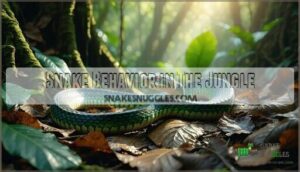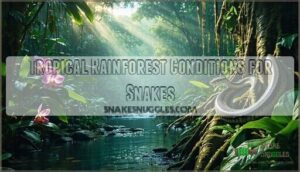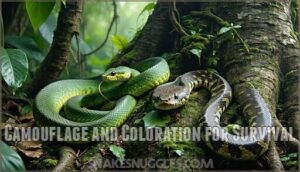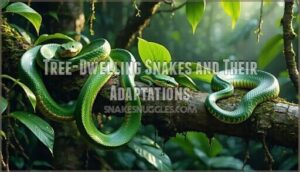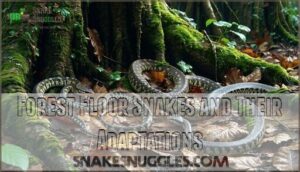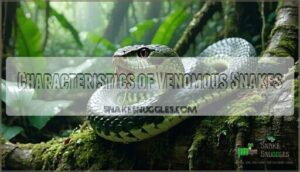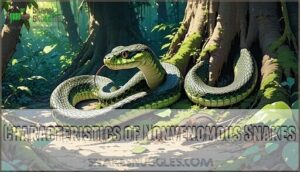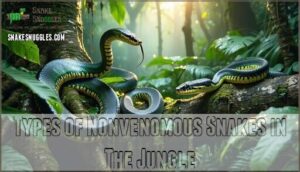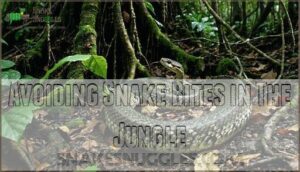This site is supported by our readers. We may earn a commission, at no cost to you, if you purchase through links.
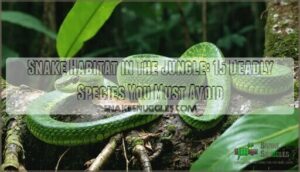
These serpents thrive in humid conditions with temperatures between 75-85°F, using fallen logs, hollow trees, and dense vegetation for shelter.
Arboreal species like green tree pythons inhabit upper branches, while ground-dwellers such as fer-de-lances prefer leaf litter and root systems.
The jungle’s abundant prey and perfect humidity levels create a snake paradise.
They’re masters of camouflage, blending seamlessly with bark patterns and leaf colors.
Understanding where these creatures make their homes becomes essential knowledge when fifteen deadly species call these same green corridors home, making them a deadly part of the ecosystem.
Table Of Contents
- Key Takeaways
- Snake Habitats in The Jungle
- Snake Behavior in The Jungle
- Rainforest Snake Habitats and Adaptations
- Venomous and Nonvenomous Jungle Snakes
- Avoiding Snake Bites in The Jungle
- Snake Bite Symptoms and Treatment
- Frequently Asked Questions (FAQs)
- Where do snakes live in the jungle?
- What is the main habitat of a snake?
- What environment do most snakes live in?
- What do snakes eat in a rainforest?
- What is snake main habitat?
- What do snakes eat in rainforests?
- What biome do most snakes live in?
- How do jungle snakes find and access water sources?
- How do jungle snakes avoid predators and competition from other species?
- How do snakes find water sources in jungles?
- Conclusion
Key Takeaways
- You’ll find jungle snakes thriving in multiple habitat layers – from the forest floor’s leaf litter where bushmasters hide, to canopy branches where green tree pythons coil, requiring 75-85°F temperatures and high humidity to survive.
- You’ll encounter both venomous species like fer-de-lances and king cobras that inject deadly toxins, plus nonvenomous constrictors like boas and anacondas that crush prey – knowing the difference can save your life.
- You’ll spot snake presence through warning signs like shed skins on branches, S-shaped tracks in soil, musky odors, and areas with fewer small animals, helping you avoid dangerous encounters before they happen.
- You’ll prevent snake bites by wearing high boots and long pants, staying on established trails, keeping calm during encounters, and never reaching into blind spots where these camouflaged predators might be hiding.
Snake Habitats in The Jungle
When you venture into jungle environments, you’ll encounter snakes thriving in diverse habitats from dense canopy layers to shadowy forest floors.
These adaptable reptiles have mastered survival in everything from moss-covered tree branches to humid leaf litter, making every step of your jungle exploration a potential encounter with one of nature’s most skilled predators, and highlighting the importance of being aware of your surroundings in such diverse habitats.
Types of Jungle Habitats for Snakes
Jungle ecosystems create diverse snake habitat zones across multiple layers.
You’ll find tropical snakes traversing Forest Floors through leaf litter, scaling Canopy Layers with prehensile tails, and exploring Caves for shelter.
Water Bodies support semi-aquatic species like anacondas, while Microhabitats in bamboo thickets offer unique niches.
Each rainforest habitat provides jungle snakes with specialized hunting grounds and survival opportunities.
Many species rely on arboreal adaptations for survival in the canopy.
Characteristics of Ideal Snake Habitats
The snake habitat in these dense environments requires specific conditions for survival.
Jungle snakes thrive when three critical elements align perfectly:
- Shelter Availability – Dense vegetation, fallen logs, and rocky crevices provide essential hiding spots
- Prey Abundance – Rodents, birds, and amphibians create a reliable food source
- Moisture Levels – High humidity supports skin shedding and prevents dehydration
Habitat complexity determines whether rainforest habitat becomes a snake environment paradise or survival nightmare.
Importance of Temperature Regulation
Being cold-blooded, jungle snakes face constant temperature challenges that shape their survival strategies. You’ll observe these behavioral adaptations as they navigate tropical environments where thermoregulation determines their metabolic rate and habitat selection.
Cold-blooded jungle snakes must constantly outsmart temperature swings to stay alive and hunt effectively.
Climate change increasingly affects these delicate processes in tropical jungles. Successful snake adaptations require precise temperature management through various strategies.
| Temperature Strategy | Snake Behavior |
|---|---|
| Morning basking | Emerald tree boas absorb sunlight |
| Midday shade-seeking | Bushmasters retreat under vegetation |
| Cool-season burrowing | Pythons dig into warm soil |
| Water thermoregulation | Anacondas use river temperatures |
| Microhabitat selection | Vipers choose ideal tree branches |
These thermoregulation strategies enable snake habitat success across diverse jungle microclimates.
Adaptations for Survival in The Jungle
These reptiles have mastered survival through remarkable adaptations that’d make any wilderness explorer take notice.
Snake camouflage techniques include color-changing abilities and pattern mimicry to blend with foliage.
Arboreal adaptations like prehensile tails help tree-dwellers navigate canopy environments, while aquatic survival features position eyes atop heads for underwater hunting.
Dietary specialization allows flexible jaws to consume large prey, and venom resistance protects against competing jungle predators.
Some species, like the twig snake, use mimicry to resemble branches.
Snake Behavior in The Jungle
Understanding snake behavior in the jungle helps you recognize potential dangers and avoid deadly encounters with venomous species.
Jungle snakes exhibit complex behavioral patterns that include specific activity schedules, hunting strategies, social interactions, and reproductive behaviors that directly affect their threat level to humans.
Activity Patterns of Jungle Snakes
Understanding snake habitat patterns helps you stay safer in dense jungle environments.
Many jungle snakes exhibit nocturnal hunting behavior, becoming active after sunset when temperatures cool and prey emerges.
Others show diurnal activity, basking in morning sunlight before seeking shade.
Crepuscular behavior peaks at dawn and dusk, when these predators exploit twilight advantages.
Seasonal changes dramatically shift activity levels, with wet seasons triggering increased movement and breeding behaviors.
Recognizing these predatory patterns helps you time jungle exploration wisely.
Hunting and Feeding Habits
When you encounter jungle snakes, you’ll witness remarkable prey selection and hunting strategies. These ambush predators employ sophisticated techniques:
- Venom effects – Neurotoxic compounds paralyze prey within minutes
- Constriction methods – Powerful coils suffocate victims through pressure
- Dietary adaptations – Flexible jaws accommodate oversized meals
Snake hunting tactics vary dramatically among species. Some jungle snakes strike lightning-fast, while others wait motionlessly for hours.
Their snake diet includes rodents, birds, and amphibians, with snake prey selected based on size and availability in their territory.
Social Behavior and Interactions
Beyond their hunting prowess, jungle snakes display complex snake communication through chemical signals and body language.
Synchronized hunting occurs when multiple snakes coordinate attacks, maximizing success rates.
Territorial defense involves scent-marking and aggressive posturing to claim prime snake habitat.
Some species form temporary aggregations during feeding frenies, demonstrating that jungle snakes aren’t always loners in their jungle ecosystem.
Their tongue flicking behavior helps them detect prey.
Mating and Reproduction
Snake mating rituals in jungle habitats are truly nature’s dramatic performances.
You’ll witness fascinating reproductive strategies during breeding seasons when snakes engage in elaborate courtship dances and competitive behaviors.
Mating Rituals involve complex behaviors:
- Males compete through combat dances for female attention
- Females select suitable nesting sites for egg incubation
- Some species demonstrate remarkable parental care, guarding eggs
- Breeding seasons align with favorable jungle conditions
These reproductive strategies guarantee jungle snake populations thrive despite challenging environments.
Rainforest Snake Habitats and Adaptations
You’ll find that rainforests create perfect conditions for snakes, with their warm temperatures, high humidity, and multi-layered structure providing countless hiding spots and hunting grounds.
These environments have shaped some of nature’s most impressive adaptations, from color-changing camouflage to specialized climbing abilities that help snakes thrive in both the canopy and forest floor.
Tropical Rainforest Conditions for Snakes
You’ll find tropical rainforests offer perfect snake habitat conditions year-round.
Temperature ranges stay consistently warm between 75-85°F, while humidity levels hover near 80-95%.
Rainfall patterns create constant moisture that prevents dehydration during shedding.
The dense vegetation density provides countless hiding spots, and prey abundance from small mammals to birds guarantees these jungle snakes thrive effortlessly in their rainforest environment, with conditions that support their survival through constant moisture.
Camouflage and Coloration for Survival
Jungle snakes’ survival depends on nature’s masterful disguise techniques.
These evolutionary pressures shaped remarkable adaptations:
- Color morphs match specific microhabitats, from leaf-green vipers to bark-brown pythons
- Disruptive coloration breaks up body outlines, confusing potential threats and prey
- Mimicry adaptations let harmless species copy dangerous ones’ warning patterns
- Thermal camouflage helps regulate body temperature while staying hidden
Snake camouflage in tropical forests represents millions of years of fine-tuning for rainforest snakes’ survival needs.
Some snakes also use cryptic coloration techniques to blend seamlessly.
Tree-Dwelling Snakes and Their Adaptations
Three species of tree-dwelling snakes have mastered jungle survival through remarkable arboreal camouflage and specialized adaptations.
These jungle snakes use prehensile tails as living anchors, gripping branches while their laterally compressed bodies navigate the canopy movement with surprising grace.
Their snake camouflage perfectly mimics bark patterns and leaf colors, making them nearly invisible predators in their snake habitat.
Diet specialization varies dramatically among species, with some targeting birds while others focus on small mammals.
Many possess heat-sensing pits that detect warm-blooded prey in complete darkness.
Venom delivery systems range from rear-fanged species with mild toxins to highly venomous front-fanged hunters.
| Adaptation | Function | Species Example |
|---|---|---|
| Heat-sensing pits | Night hunting | Amazon tree boa |
| Prehensile tail | Branch anchoring | Green tree python |
| Compressed body | Enhanced balance | Emerald tree boa |
| Arboreal camouflage | Predator evasion | Vine snake |
Forest Floor Snakes and Their Adaptations
While canopy dwellers rule above, forest floor snakes dominate the jungle’s shadowy ground level through remarkable adaptations.
Forest floor snakes excel at ground hunting using sophisticated camouflage techniques to blend with leaf litter and debris. These jungle snakes demonstrate incredible burrowing behavior and specific substrate preferences that enhance their survival in dense jungle habitat.
Key snake adaptation strategies include:
- Camouflage techniques using earth-tone patterns matching forest debris
- Ground hunting methods for ambushing prey in low-light conditions
- Substrate preferences for loose soil enabling quick burrowing behavior
- Prey selection focusing on rodents, amphibians, and ground-dwelling birds
- Heat-sensing abilities compensating for limited visibility in snake habitat.
These adaptations make forest floor species perfectly suited for their challenging environment.
Venomous and Nonvenomous Jungle Snakes
You’ll encounter both venomous and nonvenomous snakes throughout jungle environments, and knowing the difference could save your life.
While venomous species like the bushmaster and coral snake pose immediate threats through toxic bites, nonvenomous constrictors such as boas and pythons rely on crushing their prey but generally avoid human contact, which is a critical aspect of jungle survival.
Characteristics of Venomous Snakes
Venomous snakes possess sophisticated venom delivery systems with specialized fangs anatomy designed for precision strikes.
Their venom toxicity varies dramatically, containing snake neurotoxins that paralyze prey or hemotoxic effects that destroy tissue.
These jungle snakes have evolved remarkably efficient hunting tools – hollow or grooved fangs that inject potent cocktails directly into victims.
Venomous snakes in tropical jungles represent nature’s most refined predators, with snake habitat adaptations perfecting their deadly arsenal over millions of years.
Types of Venomous Snakes in The Jungle
Deadly predators lurk throughout tropical jungles, each wielding specialized weapons designed for swift kills.
You’ll encounter species with neurotoxic venom that paralyzes prey, hemotoxic effects causing internal bleeding, and cytotoxic venom destroying tissue on contact.
- King Cobra – World’s longest venomous snake with paralyzing neurotoxic venom
- Gaboon Viper – Possesses 2-inch fangs delivering massive venom doses
- Fer-de-lance – Causes most snakebite fatalities in South American jungles
- Green Mamba – Lightning-fast arboreal hunter with potent neurotoxins
Characteristics of Nonvenomous Snakes
Unlike venomous jungle species, nonvenomous snakes rely on constriction methods to subdue prey rather than toxic bites.
You’ll notice their scale patterns often provide excellent camouflage against bark and leaves.
Size variations range dramatically—from slender vine snakes to massive anacondas.
Their diet preferences typically include small mammals and birds, while their habitat range spans forest floors to treetops throughout rainforest ecosystems.
Types of Nonvenomous Snakes in The Jungle
Jungle-dwelling giants like Boa Constrictors and massive Anacondas showcase impressive size variations among nonvenomous snakes.
You’ll encounter colorful Rainbow Boas, diverse Python Variations, and specialized Arboreal Constrictors throughout rainforest habitats.
These constrictor snakes rely on powerful muscles rather than venom, making them less immediately dangerous but equally impressive in jungle environments with their unique ability to thrive, and are a testament to the diverse Python Variations.
Avoiding Snake Bites in The Jungle
When exploring jungle environments, you’ll need to understand where snakes hide and how they behave to protect yourself from potentially fatal encounters.
Recognizing snake habitats, warning signs, and proper response techniques can mean the difference between a safe adventure and a medical emergency, which is crucial for a safe adventure.
Safety Precautions for Jungle Exploration
Preparing for jungle exploration requires proper snake safety gear and emergency planning.
Wear jungle footwear like boots, long pants, and carry first-aid kits for snake encounters. Consider guided tours and maintain emergency contacts.
Gear Essentials Snake Awareness Emergency Plan
Selecting the right boots offers protection from snake bites. Proper preparation prevents snake bites and guarantees safer jungle exploration adventures.
Identifying Potential Snake Habitats
Recognizing habitat indicators helps you spot where jungle snakes might lurk before you stumble into danger.
Smart explorers scan their surroundings for these telltale signs that signal prime snake habitats, including:
- Dense vegetation providing cover and shelter availability
- Areas with abundant rodents indicating prey abundance
- Water sources like streams or pools nearby
- Microclimate factors creating warm, humid pockets
- Natural hideouts such as fallen logs or rock crevices
Tropical forests create perfect conditions for rainforest snakes to thrive.
Preparing for potential bites requires knowing jungle first aid.
Warning Signs of Snake Presence
Awareness becomes your best defense when traversing jungle terrain where deadly snakes lurk. You’ll notice several key indicators that signal snake presence nearby.
Look for shed skins draped on branches, distinctive S-shaped snake tracks in soft soil, and unusual musky smells that linger in still air. Pay attention to areas with fewer small animals, as prey absence often indicates predator activity.
It’s also wise to ponder wearing snake proof boots for added protection.
| Warning Sign | What to Look For | Location |
|---|---|---|
| Shed Skins | Translucent, snake-shaped casings | On branches, rocks, logs |
| Snake Tracks | S-shaped impressions in dirt | Muddy paths, riverbanks |
| Snake Droppings | Dark, chalky pellets with bones | Near hiding spots, caves |
| Unusual Smells | Musky, cucumber-like odors | Dense vegetation areas |
| Prey Absence | Lack of small mammals/birds | Previously active zones |
What to Do in Case of a Snake Encounter
Mother Nature’s rulebook says: if you spot a snake in its jungle habitat, respect its turf.
Your best snake bite prevention is to keep cool and give it space.
Here’s a handy checklist:
- Stay Calm—don’t panic or run.
- Back Away slowly, never turning your back.
- Identify Snake if safe, for antivenom info.
- Seek Help and report sighting, especially after a snake encounter.
Snake Bite Symptoms and Treatment
If you ever find yourself bitten by a snake in the jungle, knowing the symptoms and proper treatment could make all the difference.
You’ll need to recognize warning signs quickly, stay calm, and follow the right steps to improve your chances of a safe recovery—no superhero cape required.
Recognizing Snake Bite Symptoms
When jungle snake bite symptoms hit, you’ll know it fast.
Your body’s alarm system kicks into overdrive – swelling, burning pain, and those telltale puncture wounds scream danger.
Watch for Symptom Onset within minutes – swelling, intense pain, and dual puncture marks at the Bite Location.
Venom Effects bring nausea, dizziness, and difficulty breathing. Your body’s alarm bells ring loud and clear.
Identifying Species helps determine severity, but don’t play detective long. First Response starts with recognizing these snake bite symptoms immediately.
Antivenom effectiveness depends on quick snake dangers recognition in any jungle setting.
First Aid for Snake Bites
When you’re bitten by a snake, staying calm saves lives. Your quick thinking and proper snake bite first aid can mean the difference between recovery and serious complications.
- Keep the bite below heart level – This immobilization technique slows venom spread through your bloodstream
- Clean gently with water – Basic wound care removes debris without aggressive scrubbing that could worsen tissue damage
- Remove jewelry immediately – Swelling happens fast, and you don’t want rings cutting off circulation later
- Mark swelling progression – Draw lines on skin with a pen to help medical teams track how quickly venom spreads
Having access to a suitable first-aid kit is essential in such situations.
Never attempt venom extraction or apply tourniquets – these outdated methods cause more harm than good.
Medical Treatment for Snake Bites
If you’ve been bitten by a venomous snake, antivenom remains your lifeline.
Medical professionals assess bite severity and envenomation management requirements immediately. Antivenom availability determines treatment speed—early administration within hours prevents long-term effects.
Your first response should involve calling emergency services while monitoring snake bite symptoms.
Hospital teams provide intravenous antivenom, supportive care, and continuous monitoring for ideal snake bite medical treatment outcomes.
Prevention of Snake Bites and Attacks
Prevention starts long before any snake encounter occurs. Smart jungle exploration requires proper preparation and awareness of your surroundings.
Key snake bite prevention techniques include:
- Jungle footwear protection: Wear sturdy, high-top boots that cover your ankles completely
- Avoidance strategies: Stay on established trails and avoid reaching into blind spots
Snake identification skills prove invaluable during jungle exploration. Learn to recognize venomous species before entering their territory. First aid knowledge serves as your backup plan, but prevention remains your primary defense against snake bites.
Frequently Asked Questions (FAQs)
Where do snakes live in the jungle?
You’ll find snakes living throughout the jungle’s layers – from forest floors where bushmasters hide in leaf litter.
To canopy branches where emerald tree boas coil with prehensile tails, plus near water sources and cave shelters.
What is the main habitat of a snake?
You’ll find snakes thriving in diverse habitats worldwide, from forests and grasslands to deserts and wetlands.
They’ve adapted to ground-dwelling, arboreal, and aquatic environments, choosing locations that offer shelter, prey, and proper temperature regulation for survival, which is crucial for their survival.
What environment do most snakes live in?
You’ll find snakes thriving in diverse environments worldwide, from tropical rainforests and deserts to grasslands and wetlands. Most species prefer warm, humid climates with abundant prey and shelter options available.
What do snakes eat in a rainforest?
In rainforests, you’ll find snakes eating rodents, birds, frogs, lizards, fish, and even other snakes. Larger species like anacondas hunt deer and caimans, while smaller ones target insects.
What is snake main habitat?
Like a tapestry woven through Earth’s landscapes, you’ll find snakes threading through virtually every habitat except Antarctica.
They’ve mastered forests, deserts, grasslands, wetlands, and even urban areas, adapting their bodies and behaviors to thrive wherever prey and shelter exist.
What do snakes eat in rainforests?
You’ll find rainforest snakes devouring diverse prey including rodents, birds, bats, frogs, lizards, fish, and even deer.
Constrictors like anacondas tackle larger mammals, while venomous species target smaller creatures with precision strikes.
What biome do most snakes live in?
Most snakes thrive in tropical and temperate regions worldwide, but you’ll find the highest diversity in warm, humid environments like rainforests, grasslands, and deserts where prey is abundant.
How do jungle snakes find and access water sources?
You’ll discover that jungle snakes use multiple strategies to locate water.
They follow humid air currents, track prey to water sources, and rely on specialized heat-sensing abilities to detect moisture-rich areas like streams and pools.
How do jungle snakes avoid predators and competition from other species?
When push comes to shove, you’ll survive by mastering camouflage, choosing strategic hiding spots, and timing your activities carefully.
You’ll blend with surroundings, avoid peak hunting hours, and use chemical signals to communicate danger while staying motionless when threatened.
How do snakes find water sources in jungles?
You’ll spot snakes detecting moisture through specialized heat sensors that locate humid microclimates near streams.
They follow scent trails left by other animals heading to water, plus track temperature gradients leading toward cooler, wetter areas in dense jungle vegetation, utilizing specialized heat sensors.
Conclusion
Congratulations, you’ve now mastered the art of not becoming snake food during your jungle adventures.
Understanding snake habitat in the jungle isn’t just academic knowledge—it’s your survival toolkit. You’ve learned where these serpents hide, how they hunt, and most importantly, how to avoid unwanted encounters.
Remember, respecting their space means they’ll respect yours. Stay alert, wear proper gear, and you’ll navigate these incredible ecosystems safely while appreciating nature’s most misunderstood predators from a comfortable distance, keeping in mind the importance of jungle adventures and maintaining a safe distance.
- https://study.com/academy/lesson/rainforest-snakes-facts-lesson-for-kids.html
- https://nationalzoo.si.edu/animals/green-tree-python
- https://aaacwildliferemoval.com/blog/snakes/a-snakes-habitat/
- https://pmc.ncbi.nlm.nih.gov/articles/PMC10363785/
- https://www.sciencedirect.com/science/article/pii/S2542519624000056

